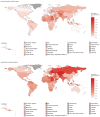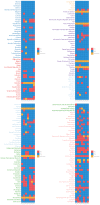The Heart of the World
- PMID: 38273998
- PMCID: PMC10809869
- DOI: 10.5334/gh.1288
The Heart of the World
Abstract
Cardiovascular diseases (CVDs) are the leading cause of mortality globally. Of the 20.5 million CVD-related deaths in 2021, approximately 80% occurred in low- and middle-income countries. Using data from the Global Burden of Disease Study, NCD Risk Factor Collaboration, NCD Countdown initiative, WHO Global Health Observatory, and WHO Global Health Expenditure database, we present the burden of CVDs, associated risk factors, their association with national health expenditures, and an index of critical policy implementation. The Central Europe, Eastern Europe, and Central Asia region face the highest levels of CVD mortality globally. Although CVD mortality levels are generally lower in women than men, this is not true in almost 30% of countries in the North Africa and Middle East and Sub-Saharan regions. Raised blood pressure remains the leading global CVD risk factor, contributing to 10.8 million deaths in 2019. The regions with the highest proportion of countries achieving the maximum score for the WHF Policy Index were South Asia, Central Europe, Eastern Europe, and Central Asia, and the High-Income regions. The Sub-Saharan Africa region had the highest proportion of countries scoring two or less. Policymakers must assess their country's risk factor profile to craft effective strategies for CVD prevention and management. Fundamental strategies such as the implementation of National Tobacco Control Programmes, ensuring the availability of CVD medications, and establishing specialised units within health ministries to tackle non-communicable diseases should be embraced in all countries. Adequate healthcare system funding is equally vital, ensuring reasonable access to care for all communities.
Keywords: CVD global data; CVDs risk factors; Cardiovascular health; WHF observatory; WHF policy index.
Copyright: © 2024 The Author(s).
Conflict of interest statement
The authors have no competing interests to declare.
Figures










References
-
- Cardiovascular diseases (CVDs). [cited 24 Jul 2023]. Available https://www.who.int/news-room/fact-sheets/detail/cardiovascular-diseases....
-
- Website. Available. https://www.who.int/publications/i/item/ncd-surveillance-global-monitori....
Publication types
MeSH terms
LinkOut - more resources
Full Text Sources

